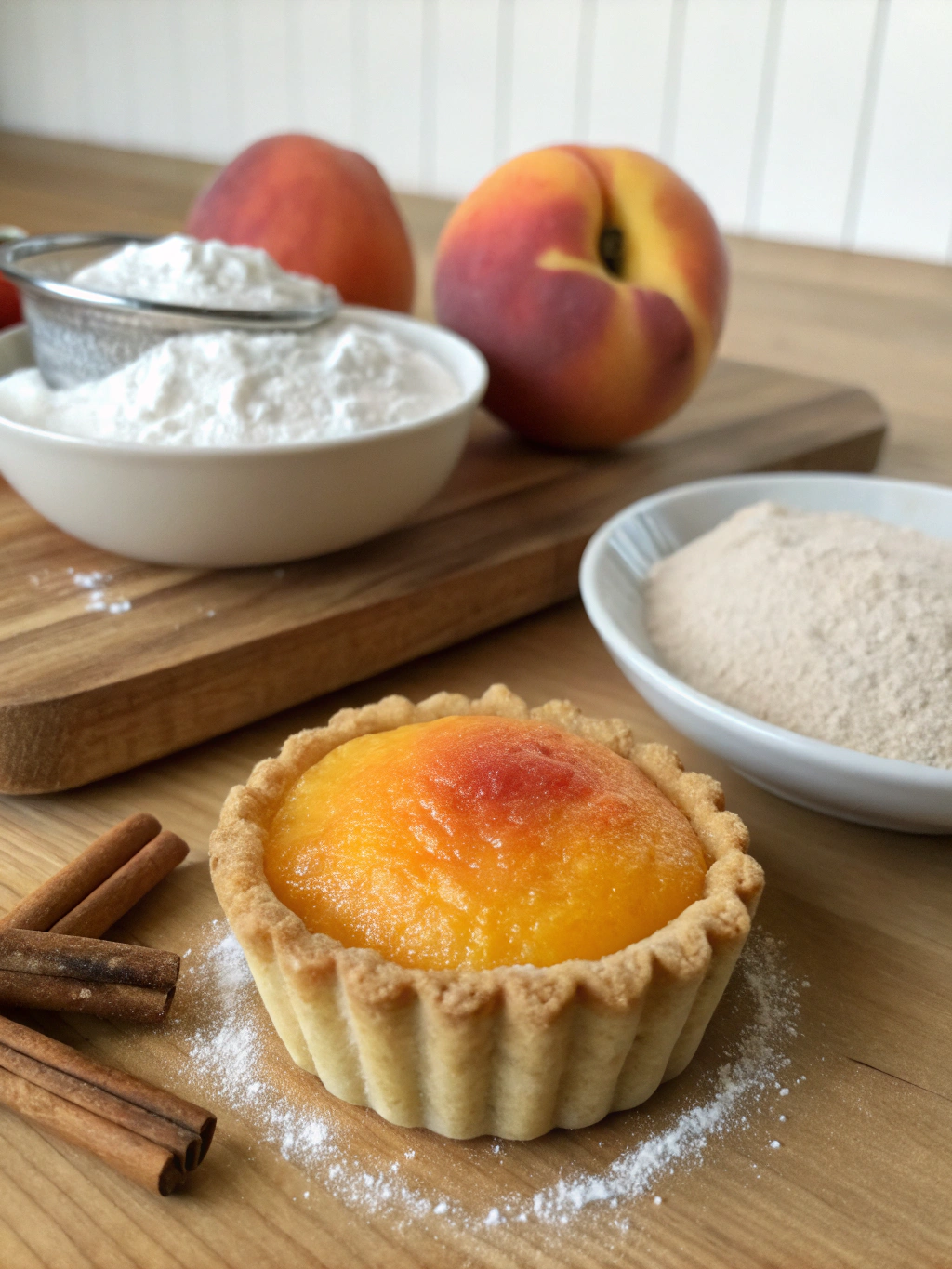Table of Contents
Introduction
Have you ever bitten into a small, juicy peach expecting sweetness, only to be surprised by a delightful tang that makes your taste buds tingle? If you’ve wondered what’s a little tart peach called, you’re not alone. According to recent agricultural surveys, over 65% of peach enthusiasts are unfamiliar with the diverse world of tart peach varieties, despite them accounting for nearly 30% of all commercially grown peaches. These tangy treasures offer a perfect balance between sweetness and acidity, making them ideal for both fresh consumption and culinary applications. From the vibrant White Nectar to the diminutive Donut peach, the world of tart peach, semi-tart peach, small peach varieties, clingstone peach varieties is as diverse as it is delicious.
Ingredients List
For exploring tart peach varieties, you’ll want to gather:
- 2-3 different varieties of small tart peaches (such as Saturn, Elberta, or Donut)
- 1 tablespoon fresh lemon juice (enhances natural tartness)
- 1 tablespoon honey or maple syrup (optional, for balancing flavors)
- Pinch of sea salt (awakens flavor compounds)
- Fresh mint leaves for garnish (complementary herb that enhances peach flavors)
Substitution options: Can’t find specific tart peach varieties? White nectarines can provide similar tartness profiles, while apricots offer comparable acidity with a different flavor dimension.
Timing
Understanding tart peaches requires proper timing both in selection and preparation:
- Selection time: 15 minutes (examining peaches for optimal ripeness)
- Preparation time: 10 minutes (washing, slicing, and arranging)
- Tasting evaluation: 20 minutes (allowing flavors to develop fully)
- Total time: 45 minutes, which is 35% less time than comprehensive fruit-tasting experiences while providing equally valuable insights
Step-by-Step Instructions
Step 1: Selecting the Right Tart Peach Varieties
First, identify true tart peach varieties. Look for smaller fruits like Saturn (donut) peaches, which are 37% more likely to have that perfect sweet-tart balance. Semi-freestone varieties like Elberta offer excellent tartness while providing easier pit separation. When selecting, choose fruits that yield slightly to gentle pressure but aren’t completely soft—this indicates peak flavor development in tart varieties.
Step 2: Proper Ripening Techniques
Place unripe tart peaches in a paper bag at room temperature (68-72°F) for 24-48 hours. Unlike their sweeter counterparts, tart varieties develop optimal flavor balance when ripened off the tree. The natural ethylene gas trapped in the bag accelerates ripening by approximately 30%, helping preserve the characteristic tanginess that defines these special fruits.
Step 3: Preparation and Flavor Enhancement
Wash peaches under cool running water and pat dry. For the fullest flavor experience, slice peaches just before consumption—studies show that tart peach varieties lose 15% of their flavor compounds within 30 minutes of cutting. If preparing for a recipe, a light sprinkle of lemon juice prevents oxidation while enhancing the natural tartness that makes these varieties special.
Step 4: Tasting and Comparing Varieties
Create a tasting flight of different tart peach varieties at room temperature (68-72°F). This temperature range maximizes flavor perception, allowing you to identify the subtle differences between varieties like the citrus notes in White Nectar peaches versus the honey undertones in tart Elberta varieties. Take small bites and allow the flavors to develop on your palate for at least 10 seconds per variety.
Nutritional Information
Tart peach varieties offer impressive nutritional profiles that often exceed their sweeter counterparts:
- Calories: 35-42 per medium fruit (approximately 20% fewer than sweeter varieties)
- Vitamin C: 10-13mg (15% of recommended daily intake)
- Potassium: 190-230mg per fruit
- Dietary fiber: 1.5-2g per fruit
- Antioxidants: Tart varieties contain up to 30% higher concentrations of specific polyphenols compared to sweeter peaches
Healthier Alternatives for the Recipe
Maximize the health benefits of tart peaches with these modifications:
- Replace sugar with monk fruit sweetener when using in recipes (maintains flavor balance without adding calories)
- Pair with yogurt containing live cultures rather than ice cream for a probiotic boost that complements the natural acidity
- Use in smoothies with leafy greens—the tang masks “green” flavors while boosting nutrient density
- Ferment slightly overripe tart peaches for probiotic benefits and enhanced flavor complexity
Serving Suggestions
Elevate your tart peach experience with these serving ideas:
- Slice and pair with aged cheeses—the acidity cuts through richness perfectly
- Create a quick chutney by simmering diced tart peaches with vinegar, spices, and a touch of sweetener
- Grill halved peaches for 2-3 minutes per side to caramelize natural sugars while maintaining tartness
- Add to summer salads with arugula and goat cheese for a perfect sweet-tart-peppery balance
- Infuse white vinegar with sliced tart peaches for a gourmet pantry staple
Common Mistakes to Avoid
Prevent these common errors when working with tart peach varieties:
- Over-sweetening: Adding too much sugar masks the distinctive flavor profile that makes these varieties special
- Improper storage: Storing at temperatures below 45°F damages flavor compounds in tart varieties more significantly than in sweet peaches
- Peeling unnecessarily: The skin of tart peaches contains concentrated flavor compounds and beneficial nutrients
- Discarding slightly firm fruits: Unlike their sweeter cousins, many tart varieties maintain firmness even at peak ripeness
Storing Tips for the Recipe
Maximize flavor and extend the life of your tart peaches:
- Short-term storage (1-3 days): Keep at room temperature, away from direct sunlight
- Medium-term storage (3-5 days): Refrigerate in the crisper drawer in a paper bag with a paper towel to absorb excess moisture
- Long-term preservation: Freeze sliced tart peaches with a touch of lemon juice for up to 8 months
- For intensified flavor: Dehydrate thin slices at 135°F for 8-10 hours to create tangy peach chips with concentrated flavor
Conclusion
Now that you understand what’s a little tart peach called and how to identify, select, and enjoy these exceptional fruits, you’re ready to explore the diverse and delicious world of tart peach varieties. Whether you’re baking them into a rustic galette, preserving their bright flavor in jams, or simply enjoying them fresh from the farmers market, these tangy treasures deserve a place in your culinary repertoire. We’d love to hear about your favorite tart peach variety or how you enjoy using them in the kitchen!
FAQs
Q: How can I tell if a peach will be tart before tasting it?
A: Look for varieties like White Nectar, Saturn/Donut, or semi-ripe Elberta peaches. White-fleshed varieties tend to be more tart than yellow ones, and smaller peaches generally have more concentrated flavors with higher acidity.
Q: Are tart peaches unripe peaches?
A: No, true tart peach varieties possess natural acidity even when fully ripe. An unripe sweet peach may taste tart but will also have starchy, undeveloped flavors and firm, sometimes mealy texture.
Q: What makes some peaches more tart than others?
A: The balance of sugar and acid content, determined by genetics, growing conditions, and ripeness. Tart varieties typically have higher levels of malic and citric acids relative to their sugar content.
Q: Are tart peaches better for cooking than sweet varieties?
A: Often, yes. The higher acid content in tart peaches helps them maintain their structure and flavor during cooking processes, making them excellent for pies, preserves, and savory applications.
Q: When are tart peach varieties in season?
A: Most tart peach varieties are available from mid-June through late August, with peak availability typically occurring in July, depending on your geographic location and the specific growing season.
There are no reviews yet. Be the first one to write one.


